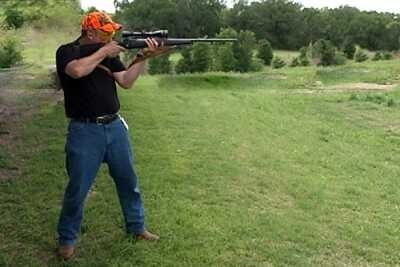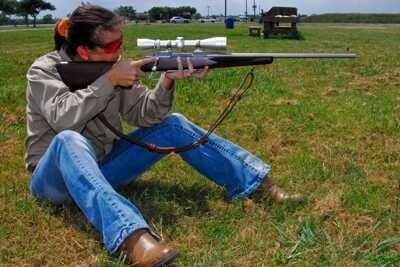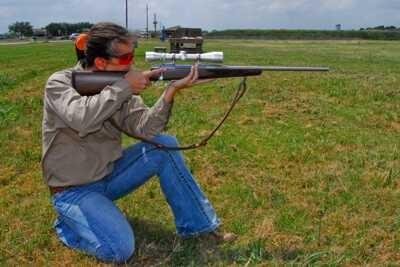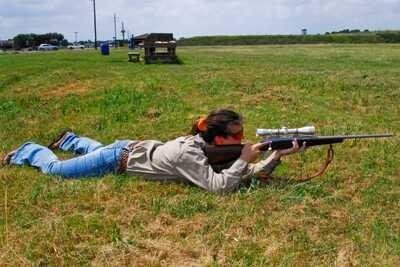Ballistics and Anti-poaching patrol for the conservation of wildlives
A. BALLISTICS AND WEAPON HANDLING
Ballistics is the study of firearms and moving projectile within and outside the firearm, the structure and working mechanism of the fire arm, behavior of flying projectile both in and outside the fire arm and the effect on the target.
Description of a Gun
A gun is a tube sealed at one end and designed for discharging a missile known as a bullet. It is so designed as to provide a maximum of safety, convenience and accuracy for the user. Its accuracy can be determined by measuring the diameter of a typical group of fire arm under an ideal condition.
Parts of a Gun
Stock
Butt
Body grip
Safety catch
Hand grip
Barrel
Muzzle
Front sight
Rear sight
Ejector
Trigger guard
Trigger

Double barrel shotgun parts.
Division of Ballistics
The stages through which a bullet undergoes from the time the trigger is pressed to the time it hits it target is divided into 3 division as listed below;
i)Internal ballistics
ii)External ballistics
iii)Terminal ballistics
i) INTERNAL BALLISTICS: This deals with the behavior and movement of the projectile from the chamber to the gun muzzle. Time factor is the major condition governing the movement and success of the bullet from the distance of the gear released to its exit at the muzzle. This is divided in 3:
- Lock Time: This is the time of gear release until the time of impact of firing pin on the primer.
- Ignition Time: this is from the time of impact on the primer until the pressure raises enough to start the bullet off from the rest.
- Barrel Time: this is interval from the when the bullet starts off from the rest until it reaches the muzzle.
ii) EXTERNAL BALLISTICS: This deals with the behavior and movement of the projectile from the muzzle to the target. As the bullet leaves the muzzle, its kinetic energy propels it in a straight line towards it target. Gravity affects the velocity and direction of the bullet.
iii)TERMINAL BALLISTICS: this deals with the behavior and effect of the bullet or projectile on the target.
Types of Gun
i) Dane gun (locally made)
ii) Shoulder rifle (single shot-long range)
iii) Short gun (multiple shots) number of missiles ranges from 80-100
iv)Pump action
v) Semi-automatic gun
vi) Automatic gun
vii)Dart gun
Importance of Ballistics
i)Self defense
ii)Anti-poaching patrol operation
iii)Research/educational programmed (use of dart gun)
iv)Management purpose (game control, -culling and cropping)
v)Treatment of animals
vi) For relocation of some park or zoo animals.
Types of Bullet or Ammunition
i) Soft nose (silver coated) used for thin skinned animal e.g. antelope family such as duiker, roan antelope.
ii) Hard nose: (copper coated) used for thick skinned animals like Elephant, Buffalo.
Cartridges
SHOOTING RANGE
A shooting range is a place where people are taught or practice how to shoot.
Factors to Be Considered In Locating a Shooting Range
i) It must be located away from human activities
ii) Must be barricade behind the target with a barrier whether natural or artificial e.g. sand bag, rock.
FIRING POSITIONS
There are four shooting positions, they include;
i)Standing position

ii)Sitting position

iii)Kneeling position

iv)Lying position

Image source
CARE AND MAINTENANCE OF FIRE ARM
i)Cleaning to avoid erosion ( eating away of the barrel)
ii)Oiling of metallic parts to prevent corrosion (slow chemical wearing)
NSP (NORMAL SAFETY PRECAUTION)
i)Treat every gun with respect due to a loaded gun
ii) Make sure your gun is unloaded and action open when not in use
iii)Have your gun cleaned before and after use or shooting to make sure it free of every foreign matter or obstruction and have only ammunition of proper size for the kind of gun you carry.
iv)Have full control of your gun with special care or direction of the muzzle in case you stumble.
v)Presses the trigger only when you are sure of the target, clearly identify the game you want to shoot.
vi) Never act a play with your gun and avoid pointing it to anything you do not intend to shoot.
vii)Unattended gun should be unloaded and ammunition kept far from the reach of children and carless adult.
viii)Never climb a tree or jump a ditch, wall or fence with a loaded gun.
viv)Never pull a gun with muzzle pointing to you. Do not put finger or hand over the muzzle.
x)Never shoot a bullet at a flat surface or surface of water, when at target practice, make sure your back stop is adequate.
xi)When transferring a fire arm to another person, make sure the barrel or weapon is pointing away from any person.
xii) Avoid alcoholic drink before and after shooting.
Principles of Marksmanship
i)Position and hold must be firm enough to support the riffle
ii) The rifle must point naturally at the target without any physical effort
iii) Sight alignment or aiming must be correct
v) The shot must be released and pass through without disturbing the position
When to Observe Safety Precautions
i)Before or after class work
ii)When picking from the ground
iii) After official duty
iv) Before or after returning from the range
v) When signing in or signing out from the arms store
Four Points In Relations To Marksman Principles
i) Master eye
ii) Back sight aperture
iii) Fore sight tip
iv) Target
B. ANTI POACHING PATROL TECHNIQUES
Introduction to Anti-Poaching Patrol:
Anti-poaching patrol can be defined as an exercise or duty performed by ranger to protect national parks against illegal activities such, hunting, illegal entry, illegal logging, illegal movement, etc. Anti-poaching patrol exercise must be planned or scheduled by an officer. It must be performed in a protected area. Patrol team must have 3 principal people;
i)The commandant
ii) The leader
iii)The rare man
The Commandant is the overall boss and must be obeyed by everyone.
The leader is someone in front who knows all the routes and directs the team to avoid loss of members and loss of team
The "rare man* is the last man in a single file. He ensures that no danger comes from behind. Every member of the team must be armed and action ready at all time. A single file must be maintained by the patrol. Whoever wants to ease himself/herself should be watch closely by others. No noise should be made while communicating. There should be no smoking. Firearms should be used in self-defense against poachers or dangerous animals. Always observe safety rules and regulations when handling firearms.
Qualities/Duties of a Park Ranger
i)Must be physically fit
ii)Must be intelligent
iii)Must be honest
iv)Must be obedient,
v)Must be discipline
vi)Must be self-confident
vii)Must have the ability to cope with the heavy work load.
viii)Must have good health
viv)Must remain calm in stressful situation (No complaining)
x)Your five(5) senses must be active
Duties
xi)To protect the park against illegal activities
xii)Must be a good park interpreter
xiii)Must be a good conservation educationist
xiv) Must have a good community relations
xv)Should be able to explain the park rules and regulations
xvi)Must be able to read the maps and directions of the park.
FIELD TECHNIQUES
Preparation For Field Operation
Planning: Kit up, water, food, first aid box
Patrol Input: expectations of the patrol, note book for recording data.
Basic Rules To Be Observed
No smoking
No noise making
Should be united
Proper handling of the fire arms/ammunition
Basic Things To Be Observed
i)Irrational cutting of trees ( cut made by hunters on trees to aid direction)
ii)Animal calls
iii)Footprints
iv)Smoke of fire
v)Gun shots
vi)scavenging birds and strong scent of animals
vii)poachers camp and unusual movement of hunters track
viii)snares/traps
viv)expended cartridges
x) polluted water
xi) bending of woody species
SURVIVAL TECHNIQUES
i)Food
ii)Water
METHODS OF PATROL
i)Ground patrol (land patrol)
ii)Marine/water patrol
iii)Aerial patrol using helicopter
TYPES OF PATROL
i)Routine patrol
ii)Surveillance patrol
iii)Reconnaissance patrol
iv)Road block patrol
v)Ambush (round and parallel ambush)
vi)Rotatory patrol
vii)Night patrol
METHODS OF POACHERS ARREST
i)Face to face arrest
ii)Court order arrest or warrant
iii)Ambushing
SIGNS USED DURING ANTI-POACHING PATROL
i)Beckoning
ii)Whispering
iii)Use of sign language and demonstration
iv) Crossing of the hands above the head by the leader to signal an obstacle in front.
"Litigation*
This is taking the first statement of the suspect after arrest. Information gathered from the suspect include; name, age, sex, occupation, tribe, residential address, time of arrest, date, place of offence, offence committed, exhibit.
Compoundment: Settlement of case outside the court and it must be initiated by the suspect showing much interest.
Congratulations! This post has been upvoted from the communal account, @minnowsupport, by simaoatb from the Minnow Support Project. It's a witness project run by aggroed, ausbitbank, teamsteem, theprophet0, someguy123, neoxian, followbtcnews, and netuoso. The goal is to help Steemit grow by supporting Minnows. Please find us at the Peace, Abundance, and Liberty Network (PALnet) Discord Channel. It's a completely public and open space to all members of the Steemit community who voluntarily choose to be there.
If you would like to delegate to the Minnow Support Project you can do so by clicking on the following links: 50SP, 100SP, 250SP, 500SP, 1000SP, 5000SP.
Be sure to leave at least 50SP undelegated on your account.
Your post has been upvoted by the @steemiansarena community trail.
Our goal is to support minnows on steemit to help them grow.
You can join our discord server here;
https://discord.gg/92ddCu
You can support us by donating steem/sbd or delegating SP to steemainsarena trail to acknowledge our mission.